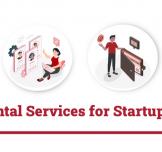UNLOCKING TECH STARTUP SECRETS; LET THE JOURNEY BEGIN

Are you ready to turn your startup dream into a reality? In this article, we'll take you through the essential steps to launch your startup successfully. From generating a game-changing idea to launching your final product or service.
We summarize the whole process in the video below, then in the rest of the article, we give more elaboration and provide a meticulously hand-picked valuable resource that you can use to dig deeper into the implementation of each milestone of the process, making this article an indispensable resource guide for aspiring entrepreneurs. So let’s dive in:
1- Start with a Great Idea
The cornerstone of a thriving startup lies in the inception of a brilliant idea, one that not only addresses a tangible problem but also seizes a distinct opportunity within a specific target segment. Ideation; the creative process of forming and refining ideas, takes center stage during this pivotal phase. It involves a dynamic combination of brainstorming sessions, engagement in design thinking practices, and tapping into personal experiences to cultivate innovative concepts. The essence of ideation goes beyond the mere generation of ideas; it encapsulates the thoughtful consideration of market needs, user pain points, and emerging trends. A successful startup idea is not arbitrary but meticulously well-defined, possessing the clarity and depth required to resonate with both the entrepreneur's vision and the demands of the market. It should stand out as a solution with the potential to make a profound and lasting impact, setting the stage for the subsequent stages of development, validation, and eventual market entry.
For more information on Design Thinking, please visit this link.
2- Do the Market Research
Conducting comprehensive market research is a critical step that serves as the compass for your entrepreneurial journey. It involves delving into fundamental questions that can shape the destiny of your startup. Firstly, ascertain the market's existence – is it real and viable for your venture? Understanding the market's reality ensures that you are not chasing an illusion but rather building on tangible opportunities.
Next, evaluate the market's size. Is it substantial enough to warrant your entry? A sizable market signifies potential customers and growth prospects, laying the foundation for a sustainable business. Simultaneously, investigate the landscape for existing solutions. Knowing what's already in the market provides insights into competition, potential gaps, and areas where innovation can thrive.
Crucially, analyze whether your proposed solution offers differential value compared to existing options. Can you address a pain point more effectively, provide a unique feature, or enhance the overall customer experience? This assessment determines your competitive edge and potential market acceptance.
In essence, the answers to these questions serve as the basis for informed decision-making. They guide you in determining whether to proceed with your idea, offering a strategic roadmap that minimizes risks and maximizes the probability of success. Market research is not just a preliminary step; it's a continual process that keeps your finger on the pulse of your industry, helping you adapt and thrive in a dynamic business landscape.
For more information on market research methods for startups, please visit this link.
3- Develop a Robust Business Model
After idea validation process from market research, including assessment of your technical capabilities, technology requirements, and the potential for business growth, the subsequent pivotal step is the development of a robust business model for your startup. At this juncture, a careful examination of your strategy for monetization and revenue generation becomes paramount.
A robust business model serves as the strategic framework that outlines how your startup will create, deliver, and capture value in the market. It involves clearly identifying your target customer segments, understanding their needs, and crafting a sustainable plan for generating revenue. This strategic blueprint not only ensures the viability of your startup but also lays the foundation for long-term profitability and success.
For more information on how to develop a robust business model, please visit this link.
4- Assemble a Balanced Founding Team
Establishing a balanced founding team is a pivotal factor to unlock your startup's full potential. The synergy within this team plays a fundamental role in steering your venture toward success. Seek collaboration with individuals whose skills not only complement your own but also bring a distinctive value to the solution you aim to provide. A well-rounded team encompasses a diversity of talents, especially in both technical and business domains.
The technical expertise ensures the seamless development and implementation of your product or service, while the business acumen contributes to strategic decision-making, market understanding, and overall sustainability. This diversity becomes a valuable asset, empowering your startup to navigate challenges with resilience and make well-informed decisions that are crucial for growth and long-term success.
For more information on secret tips of startup team development, please visit this link.
5- Develop a Prototype Towards an MVP
Entering the phase of developing a proof of concept prototype marks a pivotal moment in your startup journey. At this stage, you transition your conceptualized idea into a tangible and functional representation. This prototype serves as a powerful communication tool, enabling you to vividly convey your vision to potential stakeholders, ranging from investors eager to understand the potential of your innovation to early customers curious about the product's features and benefits.
The prototype not only brings your idea to life but also serves as a foundation for soliciting valuable feedback. Actively seek feedback from various sources, including potential users, industry experts, and even your team members. This iterative feedback loop is crucial for refining and enhancing the prototype. The ultimate goal is to evolve the initial concept into a Minimum Viable Product (MVP), a version of your product that encapsulates its core functionalities while placing a strong emphasis on an exceptional user experience.
For more information on Prototype versus MVP in software development, please visit this link.
6- Business Plan and Go-to-Market Strategy
Having achieved a clear understanding of your innovative idea and developed a functional prototype, the next step is to solidify the foundation of your startup by finalizing a comprehensive business plan. This document serves as the roadmap for your entrepreneurial journey, outlining the core elements of your venture. It encapsulates your overarching objectives, strategic approaches, and presents financial projections that provide a realistic outlook for your business's growth and sustainability.
Simultaneously, as you refine your business plan, it is imperative to craft a well-thought-out go-to-market strategy. This strategic blueprint is pivotal in defining how your product or service will be introduced to your target audience. Your go-to-market strategy should encompass a detailed analysis of your target market, a compelling value proposition, and a carefully crafted plan for product positioning, pricing, distribution channels, and promotional activities.
For more information on business plan development, please visit this link.
7- Seek Funding
Building a Minimum Viable Product (MVP) and scaling a startup are pivotal phases in the entrepreneurial journey, demanding strategic financial support. Entrepreneurs are presented with a spectrum of funding sources, each with its unique advantages.
Delve into the realm of grants, where securing financial support aligns with specific project goals or societal advancements.
- Angel investors, often experienced entrepreneurs themselves, provide not only capital but invaluable mentorship.
- Venture capital, a common avenue for high-growth startups, involves investment from specialized funds in exchange for equity.
- Contributions from family and friends signify a personal commitment to your vision, fostering a sense of trust and support.
- Consider accelerator and incubator programs, which not only offer funding but also guidance and resources.
However, in this quest for financial backing, mastery of the art of pitching is non-negotiable. Articulating your startup's value proposition neatly and convincingly is key to attracting investors. Equally important is the demonstration of effective capital management – a clear plan illustrating how funds will be utilized, showcasing fiscal responsibility and increasing investor confidence in the venture's potential for success.
For more information on startup funding and pitching tactics, please visit this link.
8- Cultivate the Right Culture
Cultivating the right organizational culture within your startup is a foundational element that significantly influences its success. It demands a deliberate focus on creating an environment where innovation flourishes.
This begins with empowering team members, instilling in them the confidence to voice their ideas, take calculated risks, and view failures as valuable learning experiences rather than setbacks. Emphasizing a culture of collaboration ensures that collective wisdom and diverse perspectives contribute to problem-solving and decision-making processes in a proactive manner.
Additionally, fostering creativity encourages novel approaches to challenges, sparking inventive solutions that can set your startup apart. Such a culture not only nurtures individual growth but also creates a dynamic and adaptive ecosystem where your team feels motivated and supported, ultimately propelling your startup to thrive in the ever-evolving business landscape.
For more information on building the right startup culture, please visit this link.
9- Network and Seek Mentorship
Networking plays a pivotal role in the success of your startup by serving as a great support link between entering the market and achieving sustainable growth. Cultivating a strong network involves establishing collaborations and agreements with other businesses, forming strategic partnerships, and engaging with industry experts. By actively participating in networking events and conferences, you create opportunities to connect with like-minded professionals who can contribute valuable insights and expertise.
Mentors and advisors, with their wealth of experience, become invaluable guides in navigating the intricate landscape of entrepreneurship. Learning from fellow entrepreneurs, sharing experiences, and building relationships can open doors to new possibilities, potential collaborations, and even funding opportunities.
For more information on networking and mentorship for startups, please visit here and here.
10- Iterate for Product-Market Fit
The journey towards product-market fit requires continuous and proactive engagement with early adopters and key stakeholders. These individuals serve as the pulse of your startup's development, offering valuable insights and perspectives. By fostering an open channel of communication, you not only gather crucial feedback on your Minimum Viable Product (MVP) but also establish a collaborative relationship with those who will ultimately shape the success of your venture.
Listening attentively to the needs and preferences of early adopters allows you to make informed and strategic adjustments to your product or service. This iterative process is essential for honing your offering, ensuring it resonates with the target audience, and aligns seamlessly with market demands. As you receive feedback, analyze patterns, and identify opportunities for enhancement, you can fine-tune your MVP, creating a product that not only meets but exceeds customer expectations.
For more information on product-market fit iterations for lean startups, please visit here.
11- Officially Launch your Startup
Once your solution is refined and your brand is well-established, it's time to register your business and officially launch. This process involves legalizing your operations, obtaining any necessary licenses or permits, and solidifying your status within the industry.
Remaining steadfastly focused on your defined market segment is imperative during this phase. Your business plan, a strategic roadmap crafted with precision, should serve as your guiding document. Ensure that you systematically fulfill the objectives outlined in your business plan, aligning your actions with the predetermined milestones and targets. This disciplined approach enhances your chances of success by maintaining a clear trajectory and fostering accountability within your team.
As you set out on the journey of official launch and market entry, anticipate challenges and setbacks as inherent components of the entrepreneurial landscape. These obstacles may manifest in various forms, from unforeseen market shifts to operational hurdles. Demonstrating resilience in the face of adversity is key. Adaptability, resourcefulness, and a proactive mindset will be your allies as you navigate the complexities of the business environment. Embrace challenges as opportunities for growth, learning, and refinement, ultimately strengthening your startup's foundation for sustained success in the competitive landscape.
For more information and some tips for your startup launch, please visit here.
That’s it. Good luck in your journey. We hope this article plays as a valuable guide for aspiring entrepreneurs, and that you find it useful for you.







































































EgyptInnovate site is not responsible for the content of the comments